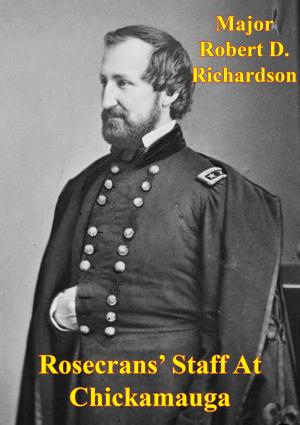Logistics In Warfare:
The Significance Of Logistics In The Army Of The Cumberland During The Tullahoma And Chickamauga Campaigns
Nonfiction, History, Modern, 19th Century, Americas, United States, Civil War Period (1850-1877), Military| Author: | Major Douglas H. Galuszka | ISBN: | 9781786253767 |
| Publisher: | Golden Springs Publishing | Publication: | November 6, 2015 |
| Imprint: | Golden Springs Publishing | Language: | English |
| Author: | Major Douglas H. Galuszka |
| ISBN: | 9781786253767 |
| Publisher: | Golden Springs Publishing |
| Publication: | November 6, 2015 |
| Imprint: | Golden Springs Publishing |
| Language: | English |
This is a study of the logistical system that supported the Union armies in the Civil War, focusing on the Army of the Cumberland under the command of Major General William S. Rosecrans in 1863. It begins with a description of the logistical bureaus in the War Department in Washington, D.C. and the challenges they had in developing the national logistical support structure in the first years of the war. Next, the support structure in the Department of the Cumberland is described, to include the challenges in maintaining the rail link from Nashville, Tennessee, back to Louisville, Kentucky. Finally, the performances of the commanders and logisticians in the field during the Tullahoma and Chickamauga Campaigns are explored, with an emphasis on the problems with transportation.
This study concludes that the logisticians overcame enormous problems to create a logistical system that allowed the commanders to win the war. In the Army of the Cumberland, the support was exceptional when compared to the challenges that were faced. Logistics became a limiting factor because of the senior leadership’s poor planning, disregarded orders, and unrealistic expectations which doomed both the Tullahoma and Chickamauga Campaigns from achieving decisive results even before they had begun.
This study attempts to put the rarely explored, but extremely significant, field of logistics in its proper place of importance in the study of military history. Logistics is inextricably tied with strategy and tactics; without logistics, victory is not possible.
This is a study of the logistical system that supported the Union armies in the Civil War, focusing on the Army of the Cumberland under the command of Major General William S. Rosecrans in 1863. It begins with a description of the logistical bureaus in the War Department in Washington, D.C. and the challenges they had in developing the national logistical support structure in the first years of the war. Next, the support structure in the Department of the Cumberland is described, to include the challenges in maintaining the rail link from Nashville, Tennessee, back to Louisville, Kentucky. Finally, the performances of the commanders and logisticians in the field during the Tullahoma and Chickamauga Campaigns are explored, with an emphasis on the problems with transportation.
This study concludes that the logisticians overcame enormous problems to create a logistical system that allowed the commanders to win the war. In the Army of the Cumberland, the support was exceptional when compared to the challenges that were faced. Logistics became a limiting factor because of the senior leadership’s poor planning, disregarded orders, and unrealistic expectations which doomed both the Tullahoma and Chickamauga Campaigns from achieving decisive results even before they had begun.
This study attempts to put the rarely explored, but extremely significant, field of logistics in its proper place of importance in the study of military history. Logistics is inextricably tied with strategy and tactics; without logistics, victory is not possible.



![Cover of the book Front Rank [Illustrated Edition] by Major Douglas H. Galuszka](https://www.kuoky.com/images/2015/november/300x300/9781786251268-PLy3_300x.jpg)


![Cover of the book Second Manassas: An Operational Dynamics Perspective. [Illustrated Edition] by Major Douglas H. Galuszka](https://www.kuoky.com/images/2014/august/300x300/9781782894209-xHCg_300x.jpg)
![Cover of the book The Gettysburg Campaign, June-July 1863 [Illustrated Edition] by Major Douglas H. Galuszka](https://www.kuoky.com/images/2015/november/300x300/9781786254382-HfLn_300x.jpg)

![Cover of the book When They Burned the White House [Illustrated Edition] by Major Douglas H. Galuszka](https://www.kuoky.com/images/2016/october/300x300/9781787201934-3qSv_300x.jpg)





